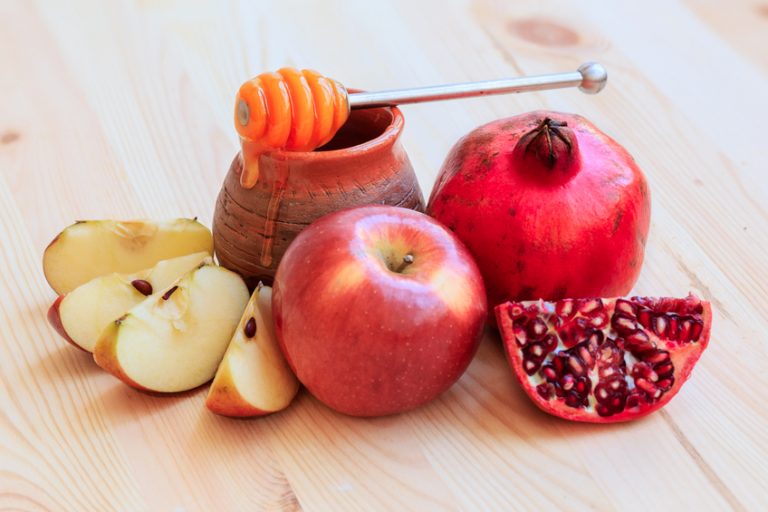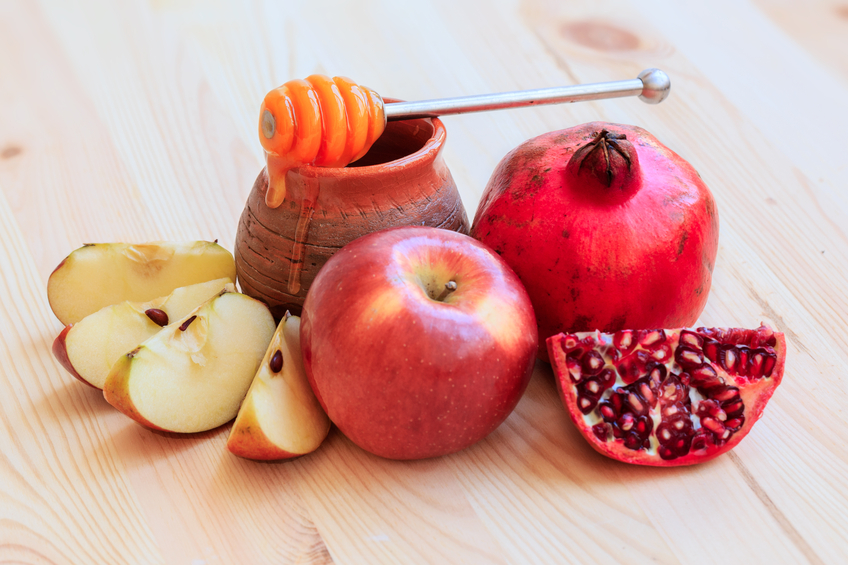 OU Kosher presents popular Q&As in preparation for Rosh Hashana. Additional questions can be asked by contacting the OU Kosher Hotline (212-613-8241) or by submitting them to kosherq@ou.org. Alternatively, CHAT LIVE with an OU Kosher expert on www.oukosher.org via the chat icon located at the bottom right-hand corner of the screen.
OU Kosher presents popular Q&As in preparation for Rosh Hashana. Additional questions can be asked by contacting the OU Kosher Hotline (212-613-8241) or by submitting them to kosherq@ou.org. Alternatively, CHAT LIVE with an OU Kosher expert on www.oukosher.org via the chat icon located at the bottom right-hand corner of the screen.
***
Honey
Q: There is a long-established minhag (custom) on Rosh Hashana night to dip an apple in honey (Shulchan Aruch OC: 583:3). What is the source of this custom to eat an apple dipped in honey?
A: The Gemara (Kerisus 6a) relates that it is customary to eat foods that have positive symbolism on Rosh Hashana. We eat these foods and recite a prayer expressing our hope that we will be blessed in the coming year. The Maharil further explains our custom to eat specifically an apple dipped in honey thus; “When the Torah mentions the ‘fragrance of the field’ (Bereishit 27:27) that Yitzchak includes in his blessing to Yaakov, this fragrance was the fragrance of apple orchards (according to many midrashim, this occurred on Rosh Hashana [Biur HaGra]), and apple orchards have Kabbalistic significance.”
Q: Isn’t there a rule that what comes from a non-kosher animal is non-kosher? Since a bee is non-kosher, how can honey be kosher?
A: The Gemara (Bechoros 7b) cites two opinions as to why bee’s honey is permitted. The Chachamim explain that honey is permitted because it is not a secretion. Rather, honey is the collected nectar in a different form, which is expelled from the bee. Rebbi Yaakov says that the permissibility of bee’s honey is derived from a Talmudic exegesis of the verse in Vayikra (11:21): “However, this you may eat from among all the flying insects…”
Q: Standard retail honey is filtered and refined. Can I use unfiltered honey for Rosh Hashanah, or must I be concerned about bee particles that may have remained?
A: Clear unfiltered honey typically undergoes some rudimentary refining steps, and most likely any bee particles will have been removed. As such, it is acceptable for use without further filtration. Nonetheless, since the honey is translucent, if you spot any particles, they should be removed. Particles can be removed on Yom Tov. On Shabbat, to avoid the issur of borer (prohibition of separating), some honey must be removed with the particle. If the honey is opaque, it most likely has not been filtered or refined at all. Opaque honey should be filtered before use. Filtering should be performed before Yom Tov or Shabbat.
Q: I have heard rumors that honey may be adulterated. Do I have to be concerned about this?
A: Although there are reports of adulteration in honey, the reports have not been substantiated. Furthermore, the alleged adulterants, even if present, are kosher sweeteners. For Pesach, one should look for Passover certified honey.
Q: Can I use honey from a honeycomb on Rosh Hashana?
A: Yes, honey may be used directly from a honeycomb. Since this honey would be unfiltered any noted particles should be removed (see question regarding unfiltered honey above). Extracting honey from a honeycomb involves the issur of mifarek (prohibition of extraction), therefore one should crush the honeycomb before Yom Tov or Shabbat (Mishnah Berurah, 321:48).
Q: What is the proper order of the brachos (blessings) and the yehi ratzon (‘may it be your will’) that is recited when the apple is dipped in honey?
A: Before eating the honey dipped apple, one should say the usual bracha over fruit (ha’eitz). Then, to avoid speaking unnecessarily between the bracha and partaking of the food, one should take a bite of the apple before reciting the yehi ratzon (Mishnah Berurah 583:4). This applies to the yehi ratzon for challah, which is also dipped in honey, as well as any other fruits/vegetables that will be served for the purposes of a yehi ratzon. It should be noted that if any of those other fruits is a member of the sheva minim (seven species attributed by the Torah to the land of Israel), they should not be brought to the table until after partaking of the apple.
Q: In addition to foods dipped in honey, are there other symbolic customs for Rosh Hashana?
A: The following is an abbreviated list of food items that are customary to eat on Rosh Hashana. Many of their symbolic meanings stem from root of their Hebrew, Aramaic or Yiddish terms.
The first three items are representative of our request of G-d to increase our mitzvos and merits as well as for the growth of our nation due to their associations with abundance and proliferation.
- Pomegranates- due to their abundance of seeds
- Fenugreek – rubya [Aramaic] whose root word means to increase (Shulchan Aruch C. 583)
- Carrots – meheren [Yiddish] whose root word means many (Chayei Adam 138:6).
The next three represent our request of G-d to protect us from our enemies, and/or our fervent prayer that our sins be nullified, by their connection to the concept of cessation.
- Leeks – karsee [Aramaic] whose root word means to cut off.
- Dates – tamarim [Hebrew] the root of which is tam – to cease.
- Beets – silka [Aramaic] whose root word means to remove
Many also eat fish as a symbol of being fruitful and multiplying like the fish in the sea. Additionally, there is a concept of being protected from the evil eye when one is out of view. Fish in particular have been referenced as being hidden in the sea and therefore concealed from the evil eye.
Q: Are there any foods that some customarily avoid during this period?
A: Some people do not eat nuts because the Hebrew word for nut is egoz, which has the same numerical value as chet (sin). Furthermore, nuts have a predisposition to cause an increase in saliva and mucus which may disturb ones concentration during prayers. (Rama O. C. 583:2). Others have a custom not to eat sour or bitter foods such as sour pickles (Matteh Ephraim, 583:3).
***
Pas Yisrael During Aseres Yimei Teshuva (Ten Days of Repentance)
The Shulchan Aruch writes that one should be careful to only eat Pas Yisroel during the Aseres Yimei Teshuva (Ten Days of Repentance), even if one does not do so the rest of the year (O.C. 603). Some are careful to eat Pas Yisroel exclusively on Shabbat and Yom Tov as well (Mishna Berurah 242:6).
Q: Which items are considered pas (bread-like items) with respect to this minhag (custom)?
A: The minhag applies to breads, cakes, pies, pretzels and crackers. (In technical terms, it applies to all pas habo bikosnin.) For an in-depth explanation of pas habo bikosnin, see The Mezonos Roll, Is it a Piece of Cake?
Q: What about breakfast cereals? Must they be Pas Yisroel?
A: There are differing opinions as to whether Cheerios is considered pas. The OU poskim do not consider it pas, because of the size of the individual pieces and the manner in which it is made. Likewise, wheat flake cereals and wafers are not considered “bread-like” and therefore do not need to be pas Yisroel. Corn and Rice Cereals are, by definition, not bread items.
Q: Do pie shells need to be Pas Yisroel?
A: Yes. A pie shell fits into the category of “pas ha’bah b’kisnin” (refer to OUKosher.com article mentioned above for a definition of this term) and therefore should also be Pas Yisroel. However, if one purchases pie shells that are not fully baked, then they will become Pas Yisroel when one completes the baking process. One should not use non-Pas Yisroel graham crackers to make their own pie shells.. Those pie shells that require further baking before being consumed become pas Yisroel.
Q: What about bread crumbs? Do they need to be Pas Yisroel?
A: Yes, bread crumbs should be Pas Yisroel as well. There were poskim who were lenient regarding bread crumbs that are used for deep frying. This is because frying is a different process than baking and the deep frying is viewed as the completion of the bread crumb preparation (see Teshuvas Avnei Nezer Y.D. 100). Since this is a matter of dispute, unless there is a pressing need, Pas Yisroel bread crumbs should be used.

